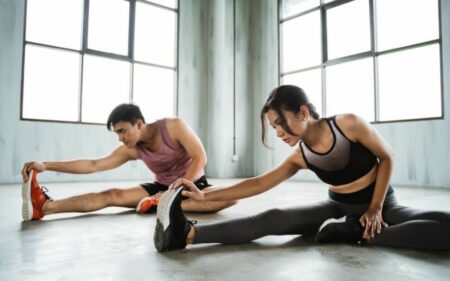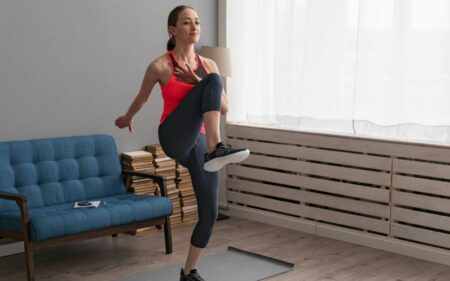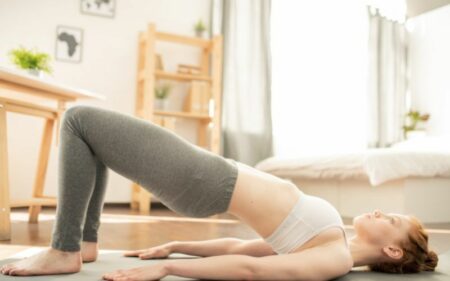One of the most common forms of physical activity and recreational pursuit all over the world is running. There is always a running style that can be tailored to your preferences, as well as a setting in which you may engage in it, whether you choose to go for a quick jog on the treadmill or are preparing to run a marathon outside in the fresh air. Running injuries may be avoided and proper form can be maintained by performing stretching and strengthening exercises on the primary muscles that are utilized while running. In here, we are going to explore about how to improve running technique with following 4 kind of exercises?
As your training advances, you will therefore be able to perform for longer periods of time and over greater distances. In order to increase your mobility in your hips and ankles and maintain an upright posture, the following four movements can be incorporated into your warming routine.

Mobility In The Ankles Can Help Enhance Upright Posture.
The most fundamental kind of a running stance is characterized by a modest forward lean. In order to do this, you need have a slight forward lean from your ankles while keeping your core firm and neutral. By increasing the flexibility in your ankles, you will be able to run with a more upright posture, which will reduce the risk of damage to your knees and lower back.
Ankle Stretch.
- Position yourself such that you are facing a wall and pressing the toes of one foot directly on the wall or door frame.
- You should put your hands on the wall for support, and then move your full weight onto the front heel of your foot.
- You should allow your body to slide forward by bending your front knee until you feel a stretch on the back of your ankle. After reaching this posture, you should gradually pulse in and out of it.
Tip: If your front knee can easily touch the wall when bent, slide your rear foot back in small increments until your front knee can no longer touch the wall when bending.

A Chin Tuck Will Help You Keep Your Neck Posture.
Keep your head up and look ahead while you’re jogging; this will help you avoid injury. If you run with your head and shoulders hunched forward while you look at the ground in front of you, your running posture will be severely compromised, and you will experience a significant loss of energy. You may avoid making this typical error by working on improving the strength of the deep cervical flexors, which are the muscles that support your head and neck.
Perform Chin Tuck.
- You should either lie on your back or stand up straight with your neck aligned neutrally to the rest of your spine.
- Tucking your chin into your chest engages the flexor muscles in your neck, which you may activate by making a head nodding action.
- Raise your head up to a little higher position, and then maintain this posture for a count of two seconds before releasing the tension in your neck and lowering your head.
- Perform this movement anywhere from six to eight times while preserving the natural bend in your neck.
Walks With High Knees And Supine Bridges Are Great Exercises To Enhance Hip Mobility.
If your hips are flexible enough, you’ll be able to move your legs using your glutes and quads while still keeping your core engaged and your spine neutral. Enhancing hip mobility is vital for developing a correct running style, as well as maintaining an upright posture and stable pelvic position.
High Knee Walks.

By performing high knee walks, you will develop the flexibility in your hips, which will allow you to elevate your knee in a forward motion while stabilizing yourself with the leg that is not being worked.
- Take a deep breath, straighten your back, and be ready to go ahead.
- You should flex your hip, bring your right knee to your chest, and grip your shin to draw your knee closer to your chest while you do this exercise.
- Maintain this position and put your attention into maintaining your chest up and your back flat.
- As you take another step forward, relax and let go of your leg, and then repeat the action on the leg on the other side of your body.
Supine Bridge.

- Lie on your back with your knees bent to a point where they are comfortable and your feet planted firmly on the ground.
- Activate your abdominal muscles to provide support for your spine, and clench your glutes to lift your pelvis off the floor.
- Raise your pelvis only as far as your glutes will allow, and under no circumstances should you arch your back to make up the difference.
- Repeat the exercise while concentrating on utilizing your glutes to elevate your hips rather than your hamstrings and lower back. Lower your hips in a controlled motion and then repeat the movement.
Bottom Line.
It is absolutely necessary to warm up in order to enhance the range of motion in your hips and ankles and to keep an upright posture. If the muscles and tendons are not properly warmed up, their performance will suffer. Because of this, there is a greater possibility that you will suffer a strain or a partial tear. Visit a medical professional if you suspect that you have a significant muscular injury. Remember to RICE (rest, ice, compression, and elevation) if your discomfort is manageable. This stands for rest, ice, compression, and elevation. You should also refrain from running until the discomfort has subsided.
FAQs
The posture, the fall, and the pull are the three fundamental elements that underlie the running motion. The more effectively you are able to execute these three fundamentals of running, the better runner you will become.
Running on your toes allows you to cover more ground and run for longer periods of time without becoming overly exhausted. When you land on your heel first, your body is forced to exert itself more, which puts you at a disadvantage. Running on your forefoot generates more force and utilizes additional muscles than running on your heels does.
Always remember to have a decent posture, activate your core, and look forward when you’re running. Avoid lowering your head and slouching your shoulders by maintaining an upright posture. Open up your chest and maintain it elevated while you pull your shoulders down and back. This will help you achieve a stronger, more powerful posture. Keep your hands flexible and swing your arms with a laid-back attitude.
You may increase the amount of oxygen you take in by breathing in through both your nose and your mouth. This can assist. While you are running, maintain a steady pace by drawing air in through your nose and mouth in alternate cycles. You may time the cycles of your breathing to the rhythm of your steps. To speed up the removal of carbon dioxide from the body, exhale via the mouth.
Get Warm up. Try not to start running without having a proper warm-up beforehand. By warming up your muscles with some dynamic stretches and low-intensity aerobic training for five to fifteen minutes before going for a run, you may assist to lessen the likelihood of sustaining an injury. Include each warm-up in your strategy for training so that you won’t be caught short of time or forced to come up with an excuse.
